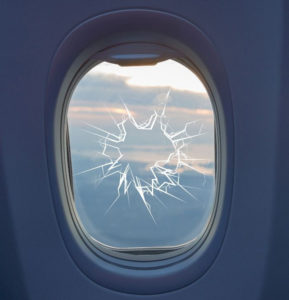
Can a plane window shatter in mid-flight?
What happens if a plane window shatters mid-flight?
Airplane windows are relatively strong. The main thing to know is that aircraft cabin windows are not made of glass but with stretched acrylic.
You won’t be able to break an airplane’s window with your fist as it has 3 layers consisting of the outer, middle and inner panes.
The outer pane is made of stretched acrylic plastic to withstand the pressurization load. If it cracks, the middle pane will take the load as this pane act as a fail-safe layer.
This material is lightweight and you can see clearly though it. The middle layer usually has a tiny hole in it to get rid of condensation.
The inner pane basically safeguards the load from the passengers during flight.
When both the outer and middle panes break, then all the pressurization in the airplane would escape leading to decompression in the passenger cabin.
A plane is pressurized for passengers’ comfort as it climbs to a higher altitude. On the ground, the surface pressure is 14.7 psi (pounds per square inch) and by 35,000 feet, it would drop to less than 4 psi creating a high differential pressure during the cruise.
Just like a balloon, when the window breaks, air will rush out. Anything loose inside the plane like phones, handbags, magazines, including humans, would be sucked out.
A rapid decompression leading to depressurization would come with a loud noise accompanied with cabin air being cooled and condensed into fog due to sudden reduction of air pressure and temperature.
Aircraft window cannot be really shattered unless by a hard object. On April 17, 2018, a Southwest Airlines Boeing 737 experienced an engine failure. The cowling in the engine broke and its fragments punctured a hole the cabin window.
One passenger sitting by the window was partially sucked out but was subsequently pulled back by a group of fellow passengers. Unfortunately, she later died due to her injuries.
There was another accident where it was not the plane window that was shattered but the cockpit windscreen became dislodged due maintenance issues. Nevertheless, the effect of the rapid depressurization is still the same.
Here, a British Airways BAC 111 suffered rapid depressurization because the forward windscreen had broken off. This caused the captain to be sucked out partially from the cockpit after he had removed his shoulder harness and loosened his lap belt.
He was forced head out first and his knees were caught on the flight controls. His upper torso remained outside and he was pinned against the window frame for about twenty minutes. Fortunately, his feet were held back by the air steward who happened to be in the cockpit.
Thankfully, the plane landed safely by the co-pilot. The captain survived this miracle with frostbite, shock and some fractures. The air steward dislocated his shoulder, also suffered frostbite and had minor injuries.
See a video ‘Jet Engine EXPLODES at 32000 Feet | Southwest Airlines Flight 1380’